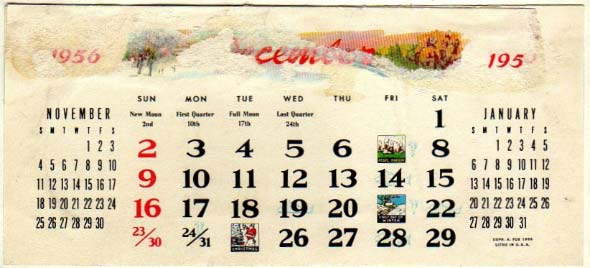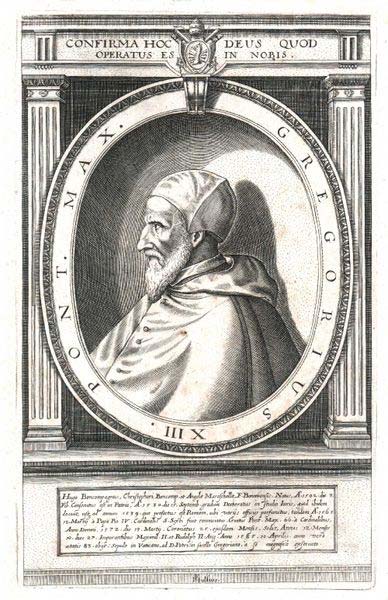The Gregorian calendar is the calendar that is used throughout most of the Western world. It began to be used from 1582. It replaced the previous Julian calendar because the Julian Calendar had an error: it added a leap year (with an extra day every four years) with no exceptions. The length of the Julian year was exactly 365.25 days, but the actual time it takes for the Earth to go around the Sun once is closer to 365.2425 days. This difference is just over ten minutes each year.

This made the seasons get out of track, since the real first day of spring in western Europe (the equinox - day and night the same length) was happening earlier and earlier before the traditional March 21 as the centuries went by. By the 1500s, it was starting around March 11, ten days 'too early' according to the calendar. So what they did was to move the calendar forward ten days in 1582, and at the same time to make sure it didn't happen again. To do this, they made an exception to the previous 'leap year rule' (add February 29 every four years). There would be no February 29 for every year that ends in 00 - unless it could be divided by 400. So the year 2000 was a leap year anyway, because it can be divided by 400, but 2100, 2200, and 2300 will be common years, with no February 29.
It was first suggested by the Neapolitan doctor Aloysius Lilius, and was made official by Pope Gregory XIII, for whom it was named, on February 24, 1582.
Adoption

It took some time for the countries to use the calender, it was not on a single momente. Spain, Portugal, the Polish-Lithuanian Commonwealth, and most of Italy started to use the new calendar on Friday, 15 October 1582, following Julian Thursday, October 4 1582. The Spanish and Portuguese colonies adopted the calendar later due to the slowness of communication in those days. France adopted the new calendar on Monday, 20 December 1582, following Sunday, December 9 1582.
The Protestant Dutch provinces of Holland and Zeeland also adopted it in December of that year, but most non-Catholic countries objected to because they said the new calendar was a Catholic invention.
The Kingdom of Great Britain and the rest of the British Empire (including the eastern part of what is now the United States) adopted the Gregorian calendar in 1752; by which time it was necessary to correct by eleven days (Wednesday, September 2 1752 being followed by Thursday, September 14 1752).
| Country | Start numbered year on 1 January |
Adoption of Gregorian Calendar |
|---|---|---|
| Denmark | between 13th - 16th centuries | 1700 |
| Venice | 1522 | 1582 |
| Holy Roman Empire | 1544 | from 1583 |
| Spain | 1556 | 1582 |
| Portugal | 1556 | 1582 |
| Prussia/td> | 1559 | 1700 |
| Sweden | 1559 | 1753 |
| France | 1564 | 1582 |
| Southern Netherlands | 1576 | 1582 |
| Lorraine | 1579 | 1682 |
| Dutch Republic | 1583 | from 1582 |
| Scotland | 1600 | 1752 |
| Russia | 1700 | 1918 |
| Tuscany | 1721 | 1750 |
| Britain and British Empire | 1752 | 1752 |
Gregorian months
A traditional mnemonic verse to remind the das of a month:
Thirty days hath September,
April, June, and November.
All the rest have thirty-one,
excepting February alone,
which hath twenty-eight.
Leap year cometh one year in four,
in which February hath one day more.
A language-independent alternative used in many countries is to hold up your two fists with the index knuckle of your left hand against the index knuckle of your right hand. Then, starting with January from the little knuckle of your left hand, count knuckle, space, knuckle, space through the months. A knuckle represents a month of 31 days, and a space represents a short month (a 28- or 29-day February or any 30-day month). The junction between the hands is not counted, so the two index knuckles represent July and August. This method also works by starting the sequence on the right hand's little knuckle, and continue toward to the left. You can also use just one hand; after counting the fourth knuckle as July, start again counting the first knuckle as August. A similar mnemonic can be found on a piano keyboard: starting on the key F for January, moving up the keyboard in semitones, the black notes give the short months, the white notes the long ones.
| Origin of month naming | |
|---|---|
| January | Janus (Roman god of gates, doorways, beginnings and endings) |
| February | Februus (Etruscan god of death) Februarius (mensis) (Latin for "month of purification (rituals)" it is said to be a Sabine word, the last month of ancient pre-450 BC Roman calendar). It is related to fever. |
| March | Mars (Roman god of war) |
| April | Modern scholars associate the name with an ancient root meaning 'other', i.e the second month of a year beginning in March. |
| May | Maia Maiestas (Roman goddess) |
| June | Juno (Roman goddess, wife of Jupiter) |
| July | Julius Caesar (Roman dictator) (month was formerly named Quintilis, the fifth month of the calendar of Romulus) |
| August | Augustus (first Roman emperor) (month was formerly named Sextilis, the sixth month of Romulus) |
| September | septem (Latin for seven, the seventh month of Romulus) |
| October | octo (Latin for eight, the eighth month of Romulus) |
| November | novem (Latin for nine, the ninth month of Romulus) |
| December | decem (Latin for ten, the tenth month of Romulus) |
The 7 day week
Each month consists of several weeks. A physical or electronic calendar provides conversion from a given date to the weekday, and shows multiple dates for a given weekday and month. Because of the irregularities in the Gregorian system, calculating the day of the week is not very simple. When the Gregorian calendar was adopted by each country, the weekly cycle continued uninterrupted. So, using the original proposed adoption date, Thursday, 4 October 1582 would be followed by Friday 15 October.
Distribution of dates by day of the week
Since the 400-year cycle of the Gregorian calendar consists of a whole number of weeks, each cycle has a fixed distribution of weekdays among calendar dates. It then becomes possible that this distribution is not even.
Because there are 97 leap years in every 400 years, there are on about 136⁄7 for each starting weekday in a cycle. The frequency is thus not the same for each weekday, which is due to the effects of the "common" centennial years (1700, 1800, 1900, 2100, 2200 etc.).
The absence of an extra day in such years causes the following leap year (1704, 1804, 1904, 2104 etc.) to start on the same day of the week as the leap year twelve years before (1692, 1792, 1892, 2092 etc.). Similarly, the leap year eight years after a "common" centennial year (1708, 1808, 1908, 2108 etc.) starts on the same day of the week as the leap year immediately prior to the "common" centennial year (1696, 1796, 1896, 2096 etc.). Thus, those days of the week on which such leap years begin gain an extra year or two in each cycle.
A leap year starting on Sunday means the next year does not start on Monday, so more leap years starting on Sunday means fewer years starting on Monday, etc. Thus the pattern of number of years starting on each day is inverted and shifted by one weekday: 58, 56, 58, 57, 57, 58, 56 (symmetric with respect to the high Sunday value).
The number of common years starting on each day is found by subtraction: 43, 43, 44, 43, 44, 43, 43.
The frequency of a particular date being on a particular weekday can easily be derived from the above (for dates in March and later, relate them to the next New Year).
